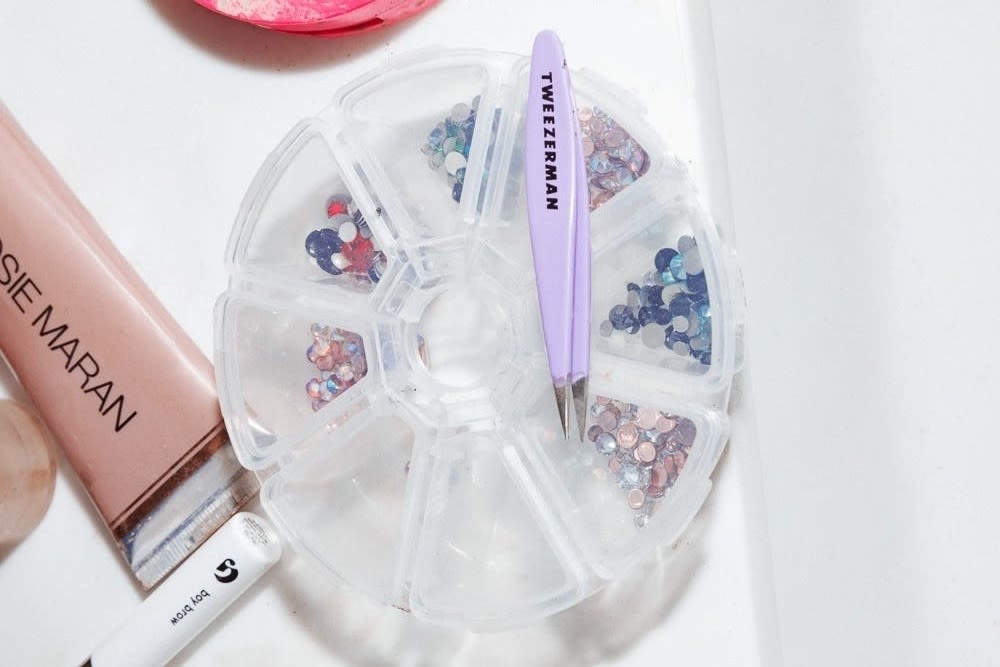So much of what we do is captured in a people-powered bounty of photos and video—you see them all in your social feeds and on the news. And while it's great when you're, say, looking for a swatch of a newly-launched lipstick, some argue that our tendency towards content-making also trades footage for individual privacy. The Janus Program, a government initiative that collects faces from social media and compiles them into a facial recognition database, compounds these privacy fears, pushing people to ask, “How can I exercise my first amendment right to protest with some level of anonymity?”
Their first and most obvious option is occlusion, the practice of physically covering one's face with a mask to shield it from cameras. But it's important to note that wearing masks in public is illegal in several states. Ironically, the anti-mask laws added to the books as a reaction against the KKK don’t provide caveats to protect protesters, who can face dire consequences if identified by those they oppose. In 1979, in the midst of the Iranian revolution, Iranian-American protesters successfully sued the state of California on the grounds that its anti-mask law put them in danger. But more recently, Alabama police called upon antiquated anti-mask laws to arrest peaceful protesters of police brutality, and the NYPD did it with Occupy Wall Street.
The other option is confusion: using one's face as a canvas of unusual shapes and bright colors. It makes standing out in a crowd inevitable, but functions as a form of digital camouflage—the complicated patterns blitz facial recognition software until it can’t register what it’s looking at. This approach is totally legal.
As those interested in exploring the limits of facial recognition have proved, the systems that exist today are easily confused. Researchers at the Chinese University of Hong Kong, Indiana University, placed infrared LED lights on the inside lip of a baseball cap to successfully make a face unidentifiable. Along the same lines, a company called Reflectacles offers “anti-surveillance” sunglasses that obscure one eye with an infrared-absorbing lens, which works because machines understand human faces to have two eyes. In the Netherlands, designer Jing-cai Liu created a wearable projector (it looks a bit like a headlamp) that projects a different face onto your own, while artist Sanne Weekers crafted an “Anonymous” scarf printed with fragmented facial features meant to overwhelm a facial recognition system. American artist Adam Harvey is exploring a similar approach with his HyperFace scarf, which was presented at the Sundance Film Festival in 2017 and is actually being developed for future purchase.
But what Harvey is most known for is Computer Vision Dazzle, a technique inspired by and named for the dazzle camouflage developed by British painter Norman Wilkinson. During World War I, Wilkinson outfitted British and Allied ships with asymmetrical stripes and shapes to distort their edges. It worked—German U-boats couldn’t properly identify the ships’ size or course, making them more difficult to hit. CV Dazzle works similarly, by obscuring key facial features until facial recognition tech can’t detect your human face as a face at all.
Harvey’s designs use choppy, colorful hairstyles and stuck-on face gems, but other artists have tried different approaches successfully, too. Joselyn McDonald does it with uber-feminine makeup and stuck-on flowers in her Mother Protect Me project; Kel Robinson uses black and white liner along with an electric blue pigment from Urban Decay to rebuild facial structures. New York’s MoMa Ps1 even focused one of its "Sunday Sessions" on the makeup technique back in 2018. The rather avant-garde hair and makeup techniques associated with the genre have since inspired makeup artists like Martayla Poellinitz, who stumbled upon the technique through a cybersecurity-focused Instagram account, to emulate the style.
However, effectively deploying the makeup at a protest is easier said than done. The London-based CV Dazzle Club revealed to Garage that they spend up to 40 minutes testing whether their makeup successfully blocks facial recognition on their iPhones before heading out on one of their monthly walks. And as Poellinitz tells ITG, she scrapped three looks before landing on something that worked. “My fourth attempt is when I added large gems for the first time,” the self-taught makeup artist explains. “That’s when I started noticing how the lights reflected off the gems. I put on more and more, and my camera started going haywire.”
For those interested in trying CV Dazzle makeup, Harvey outlines several tips on his project website. The first is to focus on obscuring key features facial recognition technology looks out for. Harvey spotlights the bridge of the nose as a critical area for transformation: If you have bangs or long hair, style it to obscure this area. Or, create visual asymmetry by covering the entire region from brow to cheekbone of one eye. Light-reflecting rhinestones are great to add if you have them on-hand, but they're not necessary. "After I figured out my first successful look, I made another one that worked using only face paint, with less clean lines and unrecognizable shapes," says Poellinitz, who emphasizes that messier is better. Those with dark complexions should use light colors and light complexions should stick to dark ones—as with contour and highlight, these shades can be used to remap facial peaks and valleys. Experiment with Cubist squares, collage-esque squiggles and lines, and Juggalo clown makeup until Instagram filters no longer work on your face.
CV Dazzle makeup may prove to be less effective as the facial recognition technology advances. But when we all return to calling lipstick our warpaint for a particularly tough day, it'll be interesting to remember this moment in makeup history, when the meaning of warpaint shifted altogether.
—Ali Oshinsky
Photo via ITG

